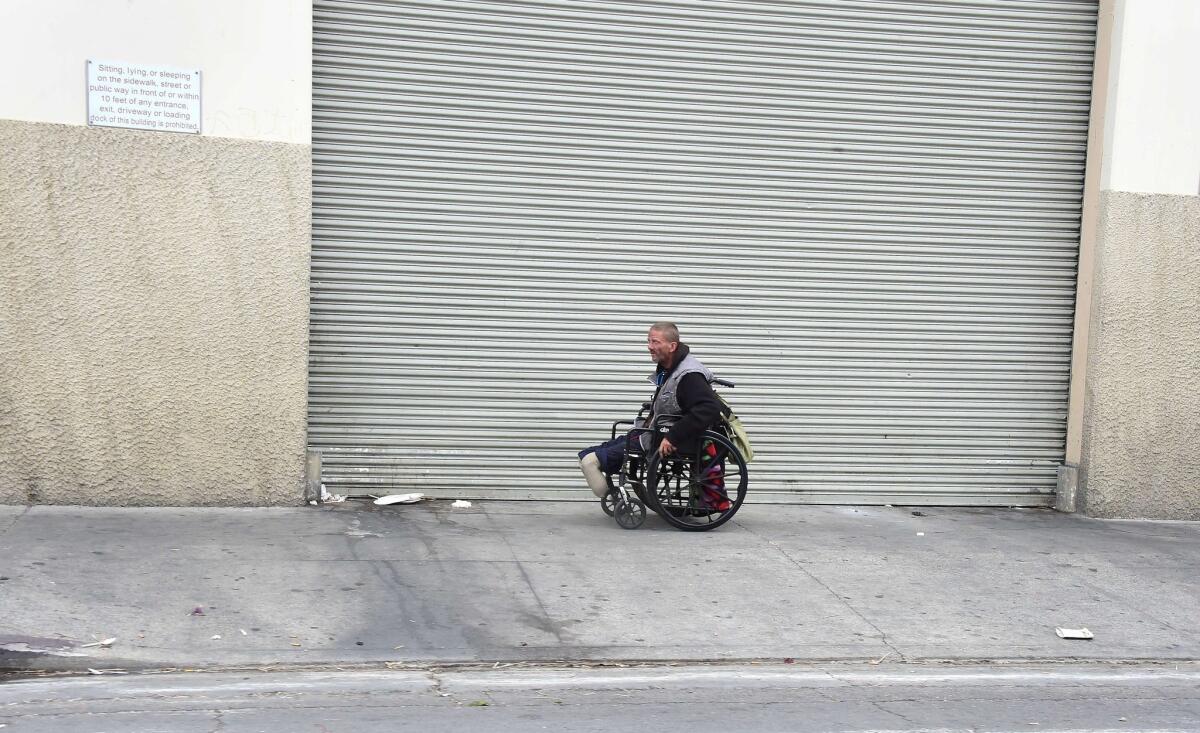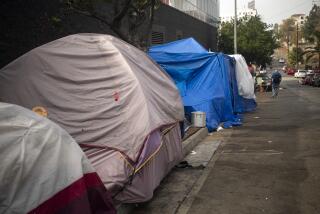Editorial: L.A.’s grim homeless data: What can be done?

A handicapped man transports himself on a wheelchair near skid row on May 12. A report released by the Los Angeles Homeless Authority on May 11 showed a 12% increase in the homeless population in both Los Angeles city and county.
The just-released results of Los Angeles County’s 2015 homeless count are unambiguously depressing. The number of homeless people in the county, which should be going down, instead has gone up 12% since 2013, to 44,359 today.
What’s more, homelessness is up not just in the usual places but everywhere in the county, in every supervisorial district from the Antelope Valley to the South Bay. And even though Los Angeles Mayor Eric Garcetti has vowed to house all the city’s homeless veterans by the end of this year, it turns out there are still 4,400 of them in the county, a drop of only 6% — with seven months to go before the mayor’s self-imposed deadline.
To be sure, ending homelessness is no easy task; the numbers reflect many of the harsh realities of this area: the lagging effects of the recession, a severe shortage of affordable housing, a drying up of federal stimulus money, gentrification downtown and elsewhere in the city. But the numbers also constitute a devastating indictment of city and county politicians, some of whom ignored the problem if it wasn’t very visible in their districts (not the case now) and all of whom failed to correct the housing shortage countywide.
There are, in fact, several homelessness problems. There’s the problem of the chronically homeless — those who have been living on the streets for more than a year and who are either mentally ill or addicted or have a physical disability. The number of chronically homeless has climbed from 7,475 in 2013 to 12,356 in 2015. It’s often hard to coax these people into shelters, and the longer-term solution for them includes building more permanent supportive housing and applying a “housing first” model that puts accommodation ahead of rehabilitation. There are also those who are “economically homeless” — people who have been without homes for a shorter period, sometimes driven out by low wages, the loss of a job, a downturn in the economy or some other financial setback. Creating good jobs, boosting the minimum wage and taking steps to solve L.A.’s affordable housing crisis would help these people.
Garcetti says he has included $10 million for the city’s Affordable Housing Trust Fund in his budget proposal and is advocating for more state and federal funding for housing. Meanwhile, Assembly Speaker Toni Atkins (D-San Diego) has introduced legislation to establish a permanent source of funding for affordable housing in the state.
All that is fine. But more is needed. The city should aggressively incentivize private developers to create low-income housing. Elected officials need to break the news to constituents that homelessness is no longer an issue downtown in skid row or on the coast in Venice — and the solutions can’t be geographically concentrated either.
Some observers believe a “homelessness czar” is needed to break down silos and encourage coordination between the many agencies and service providers involved in fighting homelessness. Maybe that would help — but maybe not. Wasn’t the Los Angeles Homeless Services Authority, a city-county agency, designed to be just such a coordinator? Yet a month ago, City Administrative Officer Miguel A. Santana reported that 15 agencies and departments spent $100 million on homelessness each year in L.A.; Santana found “no consistent process” for dealing with the homeless, and he too called for coordination.
It’s time to get serious — to make changes in policy, to devote greater resources, to figure out how to cut through bureaucracy and lack of coordination. If the city and the county don’t make this an urgent priority, these numbers will only grow.
Follow the Opinion section on Twitter @latimesopinion and Facebook
More to Read
Start your day right
Sign up for Essential California for news, features and recommendations from the L.A. Times and beyond in your inbox six days a week.
You may occasionally receive promotional content from the Los Angeles Times.






